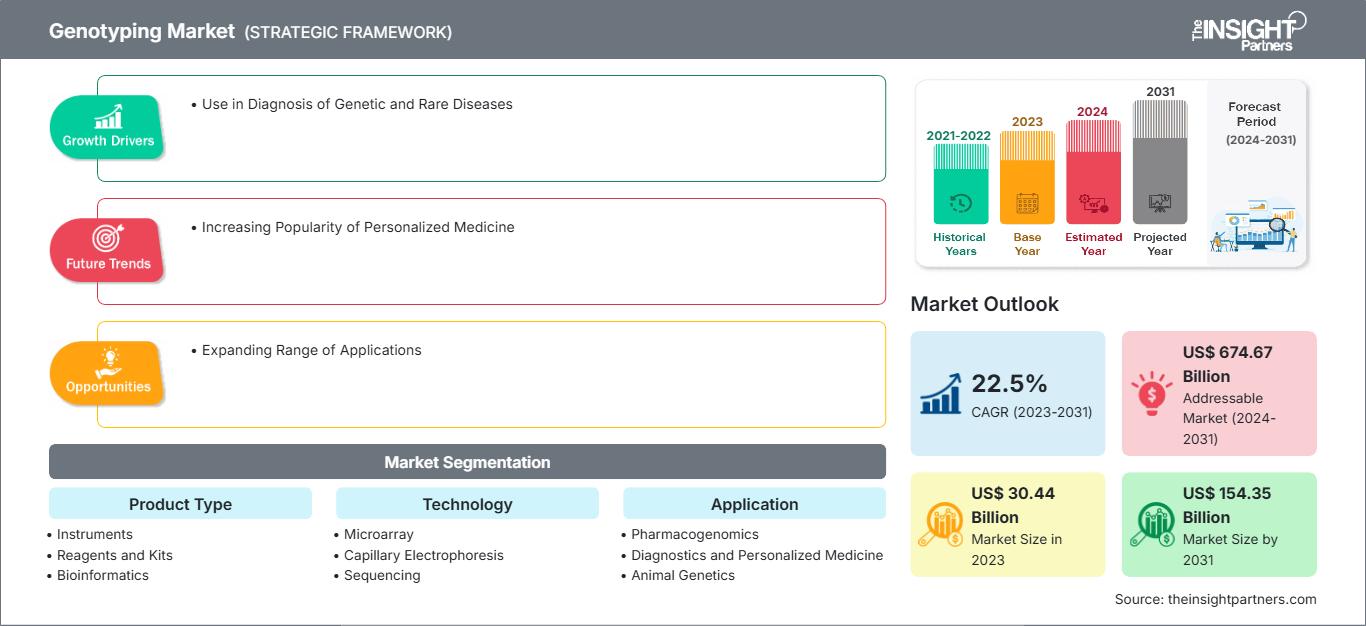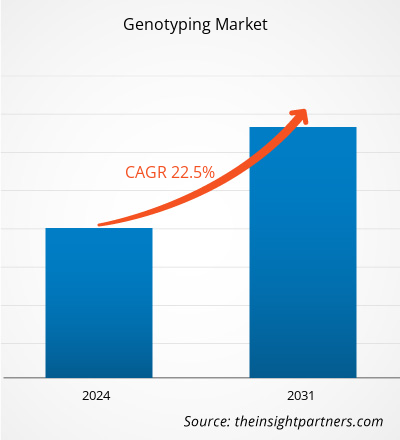Le marché du génotypage devrait atteindre 154,35 milliards de dollars américains d'ici 2031, contre 30,44 milliards de dollars américains en 2023. Le marché devrait enregistrer un TCAC de 22,5 % entre 2023 et 2031. Une gamme diversifiée d'applications du génotypage, notamment la médecine personnalisée, l'agriculture et l'élevage, grâce à des efforts et des campagnes de sensibilisation croissants, continuera d'être une tendance clé du marché.
Analyse du marché du génotypage
Le développement de technologies de génotypage à haut débit telles que le séquençage de nouvelle génération et l'analyse de puces à ADN a profité au marché du génotypage. L'utilisation croissante du génotypage dans l'agriculture et l'élevage pour améliorer les rendements des cultures, développer des cultures résistantes aux maladies et améliorer la production animale est l'un des principaux moteurs de la croissance du marché du génotypage. Les activités de R&D en cours dans les domaines de la génomique, de la génétique et des domaines connexes, menant à la découverte de nouveaux marqueurs génétiques et de leurs associations avec des maladies, contribuent également à la progression du marché.
Aperçu du marché du génotypage
L'Inde présente une prévalence relativement élevée de maladies génétiques en raison de sa vaste population, de son taux de natalité élevé et de la préférence pour le mariage consanguin dans certaines communautés. Des travaux de recherche et développement (R&D) sont menés sur la génétique humaine, l'analyse du génome et la médecine de précision afin de réduire potentiellement le fardeau de ces maladies en comprenant le spectre des mutations des maladies. Ces programmes de R&D sont axés sur la mise en œuvre de programmes de dépistage prénatal et néonatal, le développement de méthodes de diagnostic rentables pour les maladies génétiques et de thérapies abordables pour ces maladies, et la création de schémas thérapeutiques personnalisés.
Les maladies génétiques telles que le cancer sont répandues en Inde. Selon l'OMS, environ 1,41 million de personnes en Inde souffraient d'un cancer en 2022. L'article intitulé « Survie au cancer du sein en Inde dans 11 zones géographiques dans le cadre du programme national de registre du cancer » répertorie le cancer du sein comme le cancer le plus courant dans le pays, car il représente environ 28,2 % de tous les cas de cancer chez les femmes ; environ 216 108 cas de cancer du sein ont été signalés chez les femmes en 2022.
Les principaux programmes et initiatives de recherche génomique en Inde sont mentionnés ci-dessous :
- DBT – Initiative sur les méthodes uniques de gestion des maladies héréditaires (UMMID)
- GenomeIndia
- Initiative sur le microbiome humain de certaines populations endogames de l'Inde
- Programme sur les maladies monogéniques
- National Genomics Core
Ainsi, un nombre croissant de programmes et d'initiatives en matière de recherche génomique offrirait des opportunités significatives pour la croissance du marché du génotypage en Inde dans les années à venir.
Personnalisez ce rapport en fonction de vos besoins
Vous bénéficierez d’une personnalisation sur n’importe quel rapport - gratuitement - y compris des parties de ce rapport, ou une analyse au niveau du pays, un pack de données Excel, ainsi que de profiter d’offres exceptionnelles et de réductions pour les start-ups et les universités
Marché du génotypage: Perspectives stratégiques

- Obtenez les principales tendances clés du marché de ce rapport.Cet échantillon GRATUIT comprendra une analyse de données, allant des tendances du marché aux estimations et prévisions.
Vous bénéficierez d’une personnalisation sur n’importe quel rapport - gratuitement - y compris des parties de ce rapport, ou une analyse au niveau du pays, un pack de données Excel, ainsi que de profiter d’offres exceptionnelles et de réductions pour les start-ups et les universités
Marché du génotypage: Perspectives stratégiques

- Obtenez les principales tendances clés du marché de ce rapport.Cet échantillon GRATUIT comprendra une analyse de données, allant des tendances du marché aux estimations et prévisions.
Moteurs et opportunités du marché du génotypage
Utilisation dans le diagnostic des maladies génétiques et rares pour favoriser le marché
Selon l'Organisation mondiale de la santé (OMS), environ 35 millions de nouveaux cas de cancer devraient survenir d'ici 2050, soit une augmentation de 77 % par rapport aux 20 millions de cas correspondants en 2022. En 2022, l'Alzheimer's Association a déclaré que le nombre de personnes atteintes de la maladie d'Alzheimer aux États-Unis augmentait rapidement. La maladie touche plus de 6 millions d'Américains de tous âges. Selon les estimations de l'association, 6,5 millions d'Américains âgés de plus de 65 ans souffraient de la maladie d'Alzheimer en 2022, et 73 % de cette population était âgée de 75 ans ou plus. Selon une étude publiée dans le Journal of Health Monitoring, jusqu'à 300 millions de personnes dans le monde souffrent de maladies rares. Bien que les maladies individuelles soient rares, elles représentent collectivement des défis importants pour le système de santé mondial.
Le cancer, la maladie d'Alzheimer et les maladies rares étant difficiles à identifier cliniquement, le génotypage constitue la pierre angulaire des tests diagnostiques au sein de la population. Les séquences d'ADN obtenues par génotypage peuvent être comparées à des échantillons ou à des séquences de référence afin de déterminer les variations. Le génotypage est également utilisé pour détecter les polymorphismes d'un seul nucléotide (SNP), qui sont des variations mineures du complément génétique au sein de la population. Le génome humain compte près de 660 millions de SNP, ce qui en fait la variation génétique la plus répandue. De plus, en comparant les polymorphismes dans des populations saines et malades, les études d'association pangénomique (GWAS) peuvent révéler des liens entre des maladies courantes et les SNP. Les GWAS peuvent démêler les mécanismes moléculaires des maladies sous-jacentes en trouvant les causes probables. Les SNP sont même présents dans des organismes unicellulaires, comme les bactéries. Le génotypage SNP permet de différencier les isolats microbiens et pourrait même être utilisé pour identifier les souches résistantes aux antibiotiques. La détection des souches par SNP a un impact significatif sur chaque analyse pharmaceutique et clinique, et a également été utilisée en épidémiologie des maladies infectieuses.
Ainsi, l'utilisation des techniques de génotypage dans le diagnostic des maladies génétiques et rares stimule le marché du génotypage.
Élargissement de la gamme d'applications pour offrir des opportunités de marché
Le génotypage offre des applications potentielles en recherche diagnostique, en pharmacogénomique et en biotechnologie agricole. De plus, cette technique est adaptée à diverses procédures de sélection végétale, de criminalistique et de tests environnementaux. Les entreprises pharmaceutiques profitent, entre autres avancées, de la disponibilité de scores de risque polygénique, d'importantes bases de données génétiques liées aux informations de santé des patients et des données de séquençage des participants aux essais cliniques. L'Industry Pharmacogenomics Working Group (I-PWG), une association d'entreprises pharmaceutiques, participe activement à la recherche pharmacogénomique. L'I-PWG regroupe 26 entreprises membres qui mènent chaque année de nombreux essais cliniques et collectent des échantillons d'ADN de sujets dans le cadre du protocole. Axé sur la pharmacogénomique clinique, l'I-PWG vise à créer des opportunités pour les entreprises pharmaceutiques dans les années à venir. Outre son utilisation fréquente en recherche oncologique, la pharmacogénomique clinique est également utilisée pour les études PGx menées dans des domaines thérapeutiques non oncologiques tels que les maladies rares, l'immunologie et la cardiologie. Une étude plus complète, utilisant le NGS d'échantillons d'essais cliniques, permet une évaluation génomique approfondie des participants, révélant des variations génétiques courantes et rares. La PGx comprend l'étude des différences polymorphiques dans la détermination des effets génomiques des médicaments/xénobiotiques, de la réponse aux médicaments et de la sensibilité aux maladies, ainsi que des relations génotype/phénotype. Par conséquent, l'adoption croissante du génotypage dans divers domaines de recherche entraînerait à terme une augmentation de la demande pour ces techniques, créant ainsi d'importantes opportunités sur le marché dans les années à venir.
Analyse de segmentation du rapport sur le marché du génotypage
Les principaux segments ayant contribué à l'élaboration de l'analyse du marché du génotypage sont le type de produit, la technologie, l'application et l'utilisateur final.
- En fonction du type de produit, le marché du génotypage est divisé en instruments, réactifs et kits, bioinformatique et services de génotypage. Le segment des réactifs et kits détenait la plus grande part de marché en 2023.
- En fonction de la technologie, le marché du génotypage est divisé en puces à ADN, électrophorèse capillaire, séquençage, spectrométrie de masse à désorption/ionisation laser assistée par matrice-temps de vol (MALDI-ToF), réaction en chaîne par polymérase (PCR), etc. Le segment PCR détenait la plus grande part de marché en 2023.
- Par application, le marché du génotypage est segmenté en pharmacogénomique, diagnostic et médecine personnalisée, génétique animale, biotechnologie agricole, etc. Le segment diagnostic et médecine personnalisée détenait la plus grande part de marché en 2023.
- En fonction de l'utilisateur final, le marché du génotypage est divisé en sociétés pharmaceutiques et biopharmaceutiques, laboratoires de diagnostic et de recherche, instituts universitaires, etc. Le segment des sociétés pharmaceutiques et biopharmaceutiques détenait la plus grande part de marché en 2023.
Analyse des parts de marché du génotypage par zone géographique
La portée géographique du rapport sur le marché du génotypage est principalement divisée en cinq régions : Amérique du Nord, Asie-Pacifique, Europe, Moyen-Orient et Afrique. L'Amérique du Nord a dominé le marché en 2023. L'adoption croissante de produits et solutions technologiquement avancés, ainsi que l'essor des activités de recherche et développement, sont les facteurs qui ont favorisé le marché du génotypage dans cette région. De plus, les programmes gouvernementaux tels que le « All of Us Research Program », les initiatives de diverses communautés génomiques et la notoriété croissante des services de génotypage stimulent l'expansion du marché en Amérique du Nord. L'Asie-Pacifique devrait enregistrer le TCAC le plus élevé au cours de la période de prévision.
Aperçu régional du marché du génotypage
Les tendances régionales et les facteurs influençant le marché du génotypage tout au long de la période de prévision ont été analysés en détail par les analystes de The Insight Partners. Cette section aborde également les segments et la géographie du marché du génotypage en Amérique du Nord, en Europe, en Asie-Pacifique, au Moyen-Orient et en Afrique, ainsi qu'en Amérique du Sud et en Amérique centrale.
Portée du rapport sur le marché du génotypage
| Attribut de rapport | Détails |
|---|---|
| Taille du marché en 2023 | US$ 30.44 Billion |
| Taille du marché par 2031 | US$ 154.35 Billion |
| TCAC mondial (2023 - 2031) | 22.5% |
| Données historiques | 2021-2022 |
| Période de prévision | 2024-2031 |
| Segments couverts |
By Type de produit
|
| Régions et pays couverts | Amérique du Nord
|
| Leaders du marché et profils d'entreprises clés |
|
Densité des acteurs du marché du génotypage : comprendre son impact sur la dynamique des entreprises
Le marché du génotypage connaît une croissance rapide, portée par une demande croissante des utilisateurs finaux, due à des facteurs tels que l'évolution des préférences des consommateurs, les avancées technologiques et une meilleure connaissance des avantages du produit. Face à cette demande croissante, les entreprises élargissent leur offre, innovent pour répondre aux besoins des consommateurs et capitalisent sur les nouvelles tendances, ce qui alimente la croissance du marché.

- Obtenez le Marché du génotypage Aperçu des principaux acteurs clés
- Analyse historique (2 ans), année de base, prévision (7 ans) avec TCAC
- Analyse PEST et SWOT
- Taille du marché Valeur / Volume - Mondial, Régional, Pays
- Industrie et paysage concurrentiel
- Ensemble de données Excel
Rapports récents
Témoignages
Raison d'acheter
- Prise de décision éclairée
- Compréhension de la dynamique du marché
- Analyse concurrentielle
- Connaissances clients
- Prévisions de marché
- Atténuation des risques
- Planification stratégique
- Justification des investissements
- Identification des marchés émergents
- Amélioration des stratégies marketing
- Amélioration de l'efficacité opérationnelle
- Alignement sur les tendances réglementaires






















 Obtenez un échantillon gratuit pour - Marché du génotypage
Obtenez un échantillon gratuit pour - Marché du génotypage